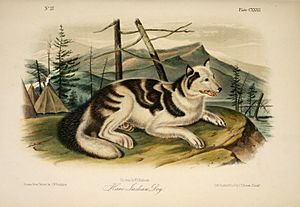Sahtu facts for kids

Hare Indian Dog and Sahtu tipis, 1845–1848
|
|
| Total population | |
|---|---|
| Canada Northwest Territories |
|
| 1,235 (2006) | |
| Languages | |
| English, Sahtu (North Slavey) | |
| Religion | |
| Christianity, Animism | |
| Related ethnic groups | |
| South Slavey |
The Sahtú or North Slavey are a group of Dene First Nations people. They live near Great Bear Lake in the Northwest Territories, Canada. The name Sahtú comes from Sahtú, which is the name for Great Bear Lake.
Sahtú communities include Colville Lake, Deline, Fort Good Hope, Norman Wells, and Tulita. These communities make up the Sahtu Region of the Northwest Territories. The Sahtú Dene Council represents the Dene people in this area. In 1993, they signed an important agreement called the Sahtu Dene and Metis Comprehensive Land Claim Agreement.
Different Sahtú groups exist. These include the Hare Dene, Bear Lake Dene, and Mountain Dene. They also call themselves Ɂehdzo Got’ı̨ne, which means "Trap People."
Contents
Who Are the Sahtú People?
The Sahtú people are part of the larger Dene family. They speak an Athabaskan language. Early explorers like Alexander Mackenzie wrote about their way of life in 1789. This was when he traveled down the Mackenzie River.
Different Sahtú Groups
Even though the Dene communities are connected, they have unique cultures and languages.
- The K’ahsho Got’ine (Hare(skin) Dene) mainly live in Fort Good Hope and Colville Lake.
- The Shita Got’ine (Mountain Dene) and K’áálǫ Got’ine (Willow Lake Dene) live together in Tulit’a.
- The Sahtúot’ine (Bear Lake Dene) are named after Great Bear Lake. They are based in Deline.
Many Métis people also live in these communities. Métis people have both Dene and European fur trader ancestors. The Hareskin Dene used to call themselves K'a so Got’ine or K’ahsho Got’ine. This means "big willow people" or "big-arrowhead-people." The name "Hareskin people" came from a mistranslation of Gahwié Got’ine, meaning "Rabbit(skin) People."
Sahtú History and the Manhattan Project
The community of Déline faced big challenges during Canada's role in the Manhattan Project. This project was about creating the first atomic bombs. To make these bombs, radioactive materials like radium were needed. These materials were found at the Eldorado Mine in Port Radium on Great Bear Lake.
Transporting Ore and Its Effects
The Sahtú Dene were hired to move the ore containing radium. This ore was sent from the Northwest Territories to be processed in Ontario or the United States. At that time, much of Europe's uranium was controlled by the Nazis. This made Canada's radium deposits very important for making the first atomic bombs.
The Sahtú Dene did not know about the dangers of radiation. They used "cloth sacks" to carry the ore. Over time, many people in Déline became very sick. A 1999 film called Village of Widows shared the stories of the Sahtú Dene. The Canadian government's reports on the number of deaths from radiation are still debated.
Sahtú Dene First Nations Today
The Sahtú Dene Council represents several First Nations today:
- Behdzi Ahda' First Nation
- They are based in Colville Lake.
- Their traditional land belongs to the K'ahsho Got'ine (Hare(skin) Dene).
- The population is about 219 people.
- Délı̨nę First Nation
- They are in Deline, which means "Where the Water Flows."
- This community is near where the Bear River flows out of Great Bear Lake.
- The Sahtúot’ine (Bear Lake Dene) traditionally fished here.
- The population is about 981 people.
- Sahtú Dene families often have ties to other Dene groups.
- In the past, they lived a nomadic life, moving with the seasons to hunt and fish.
- Many still hunt, fish, and trap to get food.
- Homes often have traditional lodges or tipis for smoking meat and fish.
- Fort Good Hope First Nation
- Also known as K’asho Gotine Dene Band.
- They are in Fort Good Hope, called Rádeyîlîkóé by the local K'ahsho Got'ine.
- This community is on the Mackenzie River.
- The population is about 869 people.
- Tulita Dene First Nation
- Also known as Tulita Band Council.
- They are in Tulit'a, meaning "Where the two Rivers Meet."
- This community was once called Fort Norman.
- The population is about 670 people.
- They are also part of the Dehcho First Nations.
Language of the Sahtú
The Sahtú people speak the North Slavey language. This language is part of the Northern Athabaskan language family. These languages are spoken in northwestern Canada.
Notable Sahtú People
Many Sahtú people have made important contributions:
- Ethel Blondin-Andrew: A former Member of Parliament for the Western Arctic.
- Rosemary Georgeson: A multi-media artist with Sahtú and Coast Salish heritage.
- Stephen Kakfwi: A politician who was the ninth Premier of the Northwest Territories.
- Rick Rivet: A Neo-expressionist painter born in 1949.
- James Wah-Shee: A former politician at the territorial level.
See also
- Hare Indian Dog
- Saoyú-ʔehdacho: A special place in Canada with spiritual and historical meaning for the Sahtú.

